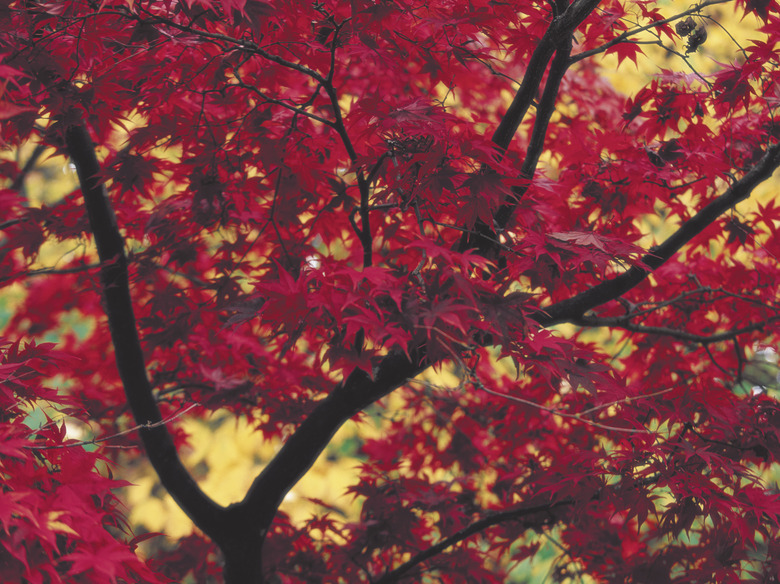Pros & Cons Of Red Maple Trees
Red maples (Acer rubrum), also called scarlet maples and swamp maples, are some of the most abundant trees growing in American forests. These colorful trees also make grand statements when planted in large lawns. Although handsome red maple trees have several benefits, they come with a few problems, too.
Pro: Colorful Features
Step 1
During the spring and summer, deciduous red maple trees bear leaves with medium green tops and light green to frosty, silvery-green undersides that glimmer in the breeze. Red maples earned their name for the brilliant fiery red, deep scarlet, dark burgundy and bright reddish-orange fall foliage. They also start showing off their fall finery before other deciduous trees and the color display typically lasts several weeks. Red maples also bear striking red flowers and fruit. The small, smoky red to pink-red blossoms bloom in dense, round clusters from late winter to early spring. The decorative blooms really stand out because they appear before the foliage emerges and few other plants are in bloom. The female flowers give way to decorative red fruits, called samaras, in summer.
- Red maples (Acer rubrum), also called scarlet maples and swamp maples, are some of the most abundant trees growing in American forests.
- During the spring and summer, deciduous red maple trees bear leaves with medium green tops and light green to frosty, silvery-green undersides that glimmer in the breeze.
Pro: Adaptable, Fast-Growing Shade Tree
Step 1
Red maple trees grow in U.S. Department of Agriculture plant hardiness zones 3 or 4 through 9. Although they thrive in moist, slightly acidic soils that receive partial shade, maples can tolerate a wide range of growing conditions, including full sun, moderate drought, wet soils, extreme temperature fluctuations and neutral to acidic soils. Their flexible nature means these trees are easy to transplant and quickly become established in various environments. Whether planted on dry slopes or in wet hollows, red maple trees provide excellent shade. They quickly grow into 40- to 70-foot specimens with canopies reaching 40 feet wide. Fast-growing red maples can reach 12 feet tall in less than five years.
Con: Root Problems
Step 1
Maple trees have shallow roots that can cause problems. Because the feeding roots lie so close to the soil's surface, turf grass and other plants often won't grow near the trees. The protruding roots are easily injured by lawn mowers. Once the roots have been damaged, the trees are susceptible to internal rot and decay. Placing a 3- to 4-inch layer of mulch beneath the canopy helps cover exposed roots and protects them from damage. Errant roots sometimes girdle maple trees around trunk bases or root balls. Circling roots gradually choke the wood tissue and can cause stunted growth, premature fall coloring and can kill red maples. You must carefully cut off circling roots as soon as you notice them to prevent future damage.
- Red maple trees grow in U.S. Department of Agriculture plant hardiness zones 3 or 4 through 9.
- Circling roots gradually choke the wood tissue and can cause stunted growth, premature fall coloring and can kill red maples.
Con: Fungal Diseases
Step 1
Maple trees occasionally contract fungal diseases, but anthracnose is the most problematic. Anthracnose primarily occurs during stretches of cool, rainy spring weather. The fungal pathogens (Gloeosporium spp.) cause small, red-brown or tan spots to appear on the leaves. The spots quickly grow and kill large sections of leaf tissue. The infected leaves often shrivel up, blacken and prematurely fall from the trees. Maple anthracnose typically isn't severe enough to need chemical treatment. Raking up and destroying fallen plant material from around the trees helps prevent fungal diseases because the pathogens have no place to overwinter. Control the spread of disease by pruning off and destroying infected branches and twigs. Thinning out overcrowded canopies helps prevent fungal diseases by increasing airflow and sunlight penetration throughout the entire tree.
- Maple trees occasionally contract fungal diseases, but anthracnose is the most problematic.
- Raking up and destroying fallen plant material from around the trees helps prevent fungal diseases because the pathogens have no place to overwinter.
References
- Ohio State University Plant Facts: Acer Rubrum — Red Maple or Swamp Maple
- Clemson Cooperative Extension: Maple
- Lady Bird Johnson Wildflower Center: Acer Rubrum
- University of Rhode Island Landscape Horticulture Program: Anthracnose Diseases of Shade Trees
- University of Florida IFAS Extension: Acer Rubrum
